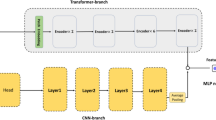Abstract
Nowadays, the evaluation of students’ learning effect in colleges and universities mainly rely on manual management and supervision, which is inefficient and inaccurate. What’s worse, it completely depends on the subjective judgment of the supervisors, many potential teaching quality data could be ignored. Using an unsupervised classroom monitoring system based on deep learning can master the learner’s learning result. This paper mainly researched a learner’s behavior evaluation method based on deep learning. Firstly, MTCNN is being used to detected learner’s facial feature in order to confirm their identification. Then, collected the data set in learning environment and a Mosaic data enhancement had been done. Later, an improved method, is proposed. Identifying the students’ actions of playing the mobile phone, moving to classroom, eating, reading, writing, this method has more advantages on classroom behavior detecting. In addition, by building a quantitative evaluation method–CFIndex (class focus index), the time of students' behaviors in classroom has been calculated. Therefore, CFIndex evaluation method can well reflect the real performance of students in the classroom. In this paper, compared with Fast R-CNN and classical algorithm on the same data set, the proposed method has better performance in classroom behavior detection, and it can better reflect the students’ real actions in the classroom, it has certain meaning of theoretical guidance.






Similar content being viewed by others
References
Cao D et al (2021) Recognition of students’s behavior states in classroom based on improved mobile net V2 algorithm. Int J Electric Eng Edu. https://doi.org/10.1177/0020720921996595
Ranjan R, Patel VM, Hyperface CR (2017) A deep multi-task learning framework for face detection, landmark localization, pose estimation, and gender recognition. IEEE Trans Pattern Anal Mach Intell 41:121–135
Zhang K, Zhang Z, Li Z et al (2016) Joint face detection and alignment using multitask cascaded convolutional networks. IEEE Signal Process Lett 23:1499–1503
Liu Y, BingHang L, Peng J, Zhang Z (2021) Research on the use of YOLOv5 object detection algorithm in mask wearing recognition. World Sci Res J 11:276–284
Wu W, Liu H, Li L, Long Y, Wang X, Wang Z et al (2021) Application of local fully convolutional neural network combined with YOLO v5 algorithm in small target detection of remote sensing image. PLoS ONE 16(10):e0259283. https://doi.org/10.1371/journal.pone.0259283
Sandha KS, Thakur A (2019) Comparative analysis of mixed CNTs and MWCNTs as VLSI interconnects for deep sub-micron technology nodes. J Electron Mater 48(4):2543–2554
Chunming Wu, Zhang Y (2021) MTCNN and FACENET based access control system for face detection and recognition. Autom Control Comput Sci 55:231–235
Hongchang Ku, Dong W (2020) Face recognition based on mtcnn and convolutional neural network. Front Sig Process 4:232
Wang Y, Yuan G, Zheng D, Hao Wu, Yuanyuan Pu, Dan Xu (2019) Research on face detection method based on improved MTCNN network. Int Conf Dig Image Process 12:262
Akash AA, Akhand MAH, Siddique N (2021) Robust face detection integrating novel skin color matching under variant illumination conditions. Int J Image, Graph Signal Process (IJIGSP) 2:13
Shifan T, Yufeng Li, Yufeng H, Xiaoyu L (2020) Face detection algorithm based on deep residual network. J Phys: Conf Ser 3:1802
Deshmukh SP, Patwardhan MS, Mahajan AR (2018) Feedback based real time facial and head gesture recognition for e-learning system. Data Sci Manag Data 5:33–38
Lu XX (2018) A review of solutions for perspective-n-point problem in camera pose estimation. J Phys: Conf Ser 5:1087
Kubíčková H, Jedlička K, Fiala R, Beran D (2020) Indoor positioning using pnp problem on mobile phone images. ISPRS Int J Geo Inf 9:45–49
Junting D, Qi F et al (2021) Fast and robust multi-person 3d pose estimation and tracking from multiple views. IEEE Trans Pattern Anal Mach Intell 585:1248
Deng Q, Zhili Wu (2018) Students’ attention assessment in elearning based on machine learning. IOP Conf Ser: Earth Environ Sci 3:199
Alejandra VRC, Raúl PE (2017) Automatic assessment of engagement and attention of the student by means of facial expressions. Front Artif Intell Appl 23:295–297
Weisler S (2015) Some perspectives on assessment of student learning. J Assess Inst Eff 5:234–235
Peng G, Lei Y, Li H, Wu D, Wang J, Liu F (2021) CORY-net: contrastive Res-YOLOv5 network for intelligent safety monitoring on power grid construction sites. IEEE Access 9:160461–160470. https://doi.org/10.1109/ACCESS.2021.3132301
Huang G, Mengwei Xu, Lin FX, Liu Y, Ma Y, Pushp S, Liu X (2017) ShuffleDog: characterizing and adapting user-perceived latency of android apps. IEEE Trans Mob Comput 16(10):2913–2926
Chen X, Lin J, Ma Y, Lin B, Wang H, Huang G (2019) Self-adaptive resource allocation for cloud-based software services based on progressive QoS prediction model. SCIENCE CHINA Information Sciences 62(11):219101
Chen X, Wang H, Ma Y, Zheng X, Guo L (2020) Self-adaptive resource allocation for cloud-based software services based on iterative QoS prediction model. Futur Gener Comput Syst 105:287–296
Chen X, Li A, Zeng X, Guo W, Huang G (2015) Runtime model based approach to IoT application development. Front Comput Sci 9(4):540–553
Huang G, Ma Y, Liu X, Luo Y, Xuan Lu, Brian Blake M (2015) Model-based automated navigation and composition of complex service mashups. IEEE Trans Serv Comput 8(3):494–506
Acknowledgements
This project is supported by [University Distinguishing Innovation Project of Guangdong Provincial Department of education in 2021 (2021KTSCX149), Key Project of Science and Technology of Dongguan Social Development in 2021 (20211800905512)].
Author information
Authors and Affiliations
Corresponding author
Additional information
Publisher's Note
Springer Nature remains neutral with regard to jurisdictional claims in published maps and institutional affiliations.
Rights and permissions
About this article
Cite this article
Liu, S., Zhang, J. & Su, W. An improved method of identifying learner's behaviors based on deep learning. J Supercomput 78, 12861–12872 (2022). https://doi.org/10.1007/s11227-022-04402-w
Accepted:
Published:
Issue Date:
DOI: https://doi.org/10.1007/s11227-022-04402-w




